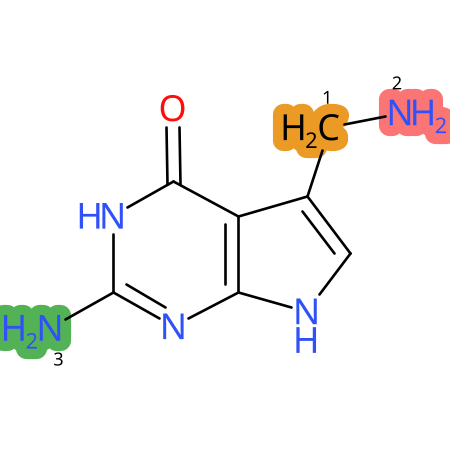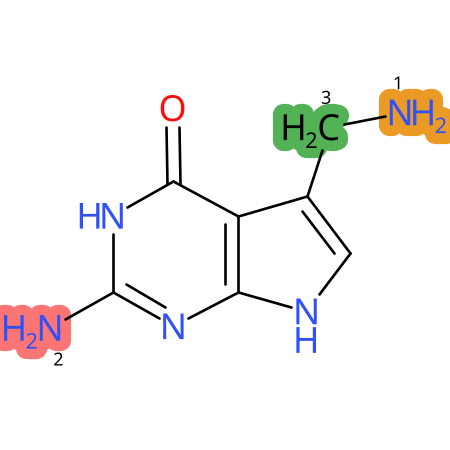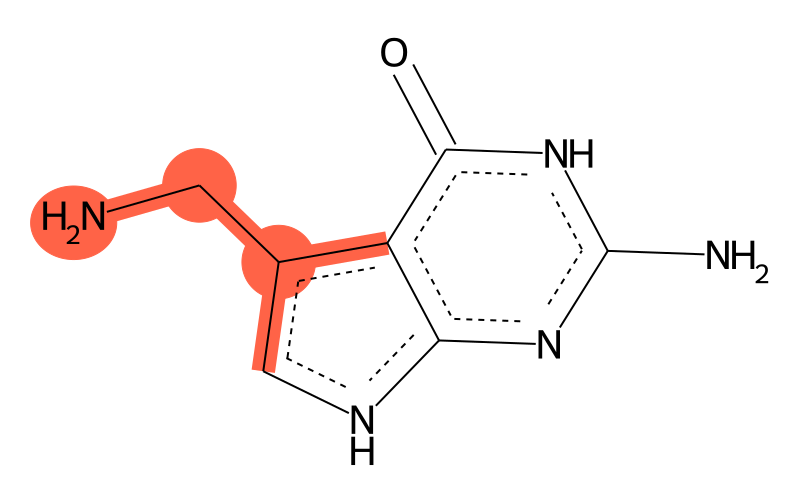Summary
| Full name | 7-aminomethyl-7-carbaguanine |
| IUPAC name | 2-amino-5-(aminomethyl)-3,7-dihydropyrrolo[2,3-d]pyrimidin-4-one |
| Short name | preQ1base |
| MODOMICS code new | 2000101000G |
| MODOMICS code | 101000G |
| Synonyms |
2-Amino-5-({[(1s,4s,5r)-4,5-Dihydroxycyclopent-2-En-1-Yl]amino}methyl)-3,7-Dihydro-4h-Pyrrolo[2,3-D]pyrimidin-4-One
2-amino-5-(aminomethyl)-1,7-dihydro-4h-pyrrolo[2,3-d]pyrimidin-4-one 2-amino-5-(aminomethyl)-1,7-dihydropyrrolo[2,3-d]pyrimidin-4-one 2-amino-5-(aminomethyl)-3,7-dihydro-4H-pyrrolo[2,3-d]pyrimidin-4-one 2-amino-5-(aminomethyl)-3H,4H,7H-pyrrolo[2,3-d]pyrimidin-4-one 2-Amino-5-(aminomethyl)-3H-pyrrolo[2,3-d]pyrimidin-4(7H)-one 2-Amino-5-(aminomethyl)pyrrolo[2,3-d]pyrimidin-4(3H)-one 69251-45-2 7-Aminomethyl-7-carbaguanine 7-aminomethyl-7-deazaguanine 7-DEAZA-7-AMINOMETHYL-GUANINE AC1L18MX C16675 CHEBI:45126 CHEMBL1235432 CID171 CTK7E3986 DB03304 HNG NS00069406 preQ1 PRF Q27120591 QEI queuine SCHEMBL166747 SCHEMBL20206657 ZINC3869370 |
| Nature of the modified residue | Natural |
| RNAMods code | ∇ |
| Residue unique ID | 61 |
| Found in RNA | Yes |
| Related nucleosides | 123 |
| Enzymes |
QueF (Escherichia coli) QueF (Bacillus subtilis) |
| Found in phylogeny | Eubacteria |
Chemical information
* Chemical properties calculated with Open Babel - O'Boyle et al. Open Babel: An open chemical toolbox. J Cheminform 3, 33 (2011) (link)
QM Data:
| Dipole Magnitude [D]: | 6.831885654 |
| Energy [Eh]: | -620.9990661752 |
| HOMO [eV]: | -7.9114 |
| LUMO [eV]: | 1.7449 |
| Gap [eV]: | 9.6563 |
Download QM Data:
| Charges | charge.txt |
Download Structures
| 2D | .png .mol .mol2 .sdf .pdb .smi |
| 3D | .mol .mol2 .sdf .pdb |
Tautomers
| Tautomers SMILES |
N=C1NC(O)c2c([nH]cc2C=N)N1 tautomer #0
N=c1[nH]c(=O)c2c([nH]cc2CN)[nH]1 tautomer #1 NC=1NC(O)c2c([nH]cc2C=N)N1 tautomer #2 Nc1nc(O)c2c([nH]cc2CN)n1 tautomer #3 NC1=NC(O)c2c([nH]cc2C=N)N1 tautomer #4 Nc1nc(O)c2-c(ncc2CN)[nH]1 tautomer #5 Nc1[nH]c(O)c2-c(ncc2CN)n1 tautomer #6 Nc1nc(=O)c2c([nH]cc2CN)[nH]1 tautomer #7 Nc1[nH]c(=O)c2c([nH]cc2CN)n1 tautomer #8 Nc1nc(O)c2c(NCC2C=N)n1 tautomer #9 Nc1nc(O)c2c(N=CC2CN)n1 tautomer #10 Nc1nc(O)c2c(NCC2=CN)n1 tautomer #11 N=c1[nH]c(O)c2c([nH]cc2CN)n1 tautomer #12 N=C1NC(=O)C2C(N=CC2C=N)N1 tautomer #13 N=C1NC(=O)C=2C(N=CC2CN)N1 tautomer #14 N=C1NC(O)C=2C(N=CC2C=N)N1 tautomer #15 N=C1NC(=O)C=2C(NCC2C=N)N1 tautomer #16 N=C1NC(O)C=2C(N=CC2CN)=N1 tautomer #17 N=C1NC(=O)C2C(NCC2C=N)=N1 tautomer #18 N=C1NC(O)C=2C(NCC2C=N)=N1 tautomer #19 N=C1NC(=O)C=2C(NCC2CN)=N1 tautomer #20 N=C1NC(=O)C2C(N=CC2CN)=N1 tautomer #21 NC1=NC(O)C2C(N=CC2C=N)=N1 tautomer #22 NC=1NC(=O)C=2C(NCC2C=N)N1 tautomer #23 NC=1NC(O)C=2C(=NCC2C=N)N1 tautomer #24 Nc1[nH]c(=O)c=2c(=NCC2CN)n1 tautomer #25 NC=1NC(=O)C=2C(N=CC2CN)N1 tautomer #26 NC=1NC(=O)C2C(N=CC2C=N)N1 tautomer #27 NC=1NC(O)C=2C(N=CC2C=N)N1 tautomer #28 N=C1NC(=O)C2C(NC=C2C=N)N1 tautomer #29 N=C1NC(=O)C2C(N=CC2=CN)N1 tautomer #30 N=C1NC(=O)C2C(NC=C2CN)=N1 tautomer #31 N=C1NC(=O)C2C(NCC2=CN)=N1 tautomer #32 N=C1NC(O)C2=C(N=CC2C=N)N1 tautomer #33 N=c1[nH]c(=O)c2c(NCC2C=N)[nH]1 tautomer #34 NC1=NC(O)C2C(N=CC2=CN)=N1 tautomer #35 NC1=NC(O)C2C(NC=C2C=N)=N1 tautomer #36 Nc1[nH]c(=O)c2c(NCC2C=N)n1 tautomer #37 NC=1NC(O)C2=C(N=CC2C=N)N1 tautomer #38 NC=1NC(=O)C2C(N=CC2=CN)N1 tautomer #39 NC=1NC(=O)C2C(NC=C2C=N)N1 tautomer #40 Nc1nc(O)c=2c(=NCC2CN)n1 tautomer #41 N=C1NC(O)C2=C(N=CC2=CN)N1 tautomer #42 N=c1[nH]c(=O)c2c(NCC2=CN)[nH]1 tautomer #43 N=c1[nH]c(=O)c2c(N=CC2CN)[nH]1 tautomer #44 Nc1[nH]c(=O)c2c(NCC2=CN)n1 tautomer #45 NC=1NC(O)C2=C(N=CC2=CN)N1 tautomer #46 Nc1nc(O)c2c(NCC2C=N)n1 tautomer #47 Nc1nc(O)c2c([nH]cc2CN)n1 tautomer #48 NC1=NC(=O)C2C(N=CC2C=N)N1 tautomer #49 NC1=NC(=O)C=2C(N=CC2CN)N1 tautomer #50 NC1=NC(O)C=2C(N=CC2C=N)N1 tautomer #51 NC1=NC(=O)C=2C(NCC2C=N)N1 tautomer #52 NC1=NC(O)C=2C(N=CC2CN)=N1 tautomer #53 NC1=NC(=O)C2C(NCC2C=N)=N1 tautomer #54 NC1=NC(O)C=2C(NCC2C=N)=N1 tautomer #55 NC1=NC(=O)C=2C(NCC2CN)=N1 tautomer #56 N=C1NC(=O)C2C(=NCC2C=N)N1 tautomer #57 N=C1NC(O)C=2C(=NCC2C=N)N1 tautomer #58 N=c1[nH]c(=O)c=2c(=NCC2CN)[nH]1 tautomer #59 NC1=NC(=O)C2C(N=CC2CN)=N1 tautomer #60 N=C1NC(O)C2C(N=CC2C=N)=N1 tautomer #61 Nc1nc(O)c2c(NCC2=CN)n1 tautomer #62 NC1=NC(=O)C2C(NC=C2C=N)N1 tautomer #63 NC1=NC(=O)C2C(N=CC2=CN)N1 tautomer #64 NC1=NC(=O)C2C(NC=C2CN)=N1 tautomer #65 NC1=NC(=O)C2C(NCC2=CN)=N1 tautomer #66 NC1=NC(O)C2=C(N=CC2C=N)N1 tautomer #67 N=C1NC(=O)C2C(=NC=C2CN)N1 tautomer #68 N=C1NC(=O)C2C(=NCC2=CN)N1 tautomer #69 N=C1NC(O)C2C(N=CC2=CN)=N1 tautomer #70 N=C1NC(O)C2C(NC=C2C=N)=N1 tautomer #71 Nc1nc(=O)c2c(NCC2C=N)[nH]1 tautomer #72 NC1=NC(O)C2=C(N=CC2=CN)N1 tautomer #73 Nc1nc(=O)c2c(N=CC2CN)[nH]1 tautomer #74 Nc1nc(=O)c2c(NCC2=CN)[nH]1 tautomer #75 NC1=NC(=O)C2C(=NCC2C=N)N1 tautomer #76 NC1=NC(O)C=2C(=NCC2C=N)N1 tautomer #77 Nc1nc(=O)c=2c(=NCC2CN)[nH]1 tautomer #78 NC=1NC(=O)C2C(=NC=C2CN)N1 tautomer #79 NC=1NC(=O)C2C(=NCC2C=N)N1 tautomer #80 N=c1nc(O)c2c([nH]cc2CN)[nH]1 tautomer #81 NC1=NC(=O)C2C(=NC=C2CN)N1 tautomer #82 NC1=NC(=O)C2C(=NCC2=CN)N1 tautomer #83 Nc1[nH]c(=O)c2c(N=CC2CN)n1 tautomer #84 NC=1NC(=O)C2C(=NCC2=CN)N1 tautomer #85 NC=1NC(O)=C2C(=NCC2C=N)N1 tautomer #86 N=C1NC(O)=C2C(N=CC2C=N)N1 tautomer #87 N=c1[nH]c(O)c2c(NCC2C=N)n1 tautomer #88 N=c1[nH]c(O)c2c(N=CC2CN)n1 tautomer #89 NC=1NC(O)=C2C(=NCC2=CN)N1 tautomer #90 NC=1NC(O)=C2C(N=CC2C=N)N1 tautomer #91 Nc1nc(O)c2c(N=CC2CN)n1 tautomer #92 N=C1NC(O)=C2C(N=CC2=CN)N1 tautomer #93 NC=1NC(O)=C2C(N=CC2=CN)N1 tautomer #94 NC=1NC(O)=C2C(NC=C2C=N)N1 tautomer #95 N=C1NC(O)=C2C(NC=C2C=N)N1 tautomer #96 N=c1[nH]c(O)c2c(NCC2=CN)n1 tautomer #97 NC1=NC(O)=C2C(N=CC2C=N)N1 tautomer #98 NC1=NC(O)=C2C(NC=C2C=N)N1 tautomer #99 NC1=NC(O)=C2C(N=CC2=CN)N1 tautomer #100 N=C1NC(O)=C2C(=NCC2C=N)N1 tautomer #101 N=c1[nH]c(O)c2-c(ncc2CN)[nH]1 tautomer #102 N=C1NC(O)=C2C(=NCC2=CN)N1 tautomer #103 NC1=NC(O)=C2C(=NCC2C=N)N1 tautomer #104 NC1=NC(O)=C2C(=NCC2=CN)N1 tautomer #105 N=C1N=C(O)C2C(N=CC2C=N)N1 tautomer #106 N=C1N=C(O)C=2C(N=CC2CN)N1 tautomer #107 N=C1N=C(O)C=2C(NCC2C=N)N1 tautomer #108 N=C1N=C(O)C2C(NCC2C=N)=N1 tautomer #109 N=C1N=C(O)C=2C(NCC2CN)=N1 tautomer #110 N=C1N=C(O)C2C(N=CC2CN)=N1 tautomer #111 NC=1N=C(O)C=2C(NCC2C=N)N1 tautomer #112 NC=1N=C(O)C=2C(N=CC2CN)N1 tautomer #113 NC=1N=C(O)C2C(N=CC2C=N)N1 tautomer #114 N=C1N=C(O)C2C(NC=C2C=N)N1 tautomer #115 N=C1N=C(O)C2C(N=CC2=CN)N1 tautomer #116 N=C1N=C(O)C2C(NC=C2CN)=N1 tautomer #117 N=C1N=C(O)C2C(NCC2=CN)=N1 tautomer #118 NC=1N=C(O)C2C(N=CC2=CN)N1 tautomer #119 NC=1N=C(O)C2C(NC=C2C=N)N1 tautomer #120 N=c1nc(O)c2c(NCC2C=N)[nH]1 tautomer #121 N=c1nc(O)c2c(N=CC2CN)[nH]1 tautomer #122 N=c1nc(O)c2c(NCC2=CN)[nH]1 tautomer #123 N=C1N=C(O)C2C(=NCC2C=N)N1 tautomer #124 N=c1nc(O)c=2c(=NCC2CN)[nH]1 tautomer #125 NC=1N=C(O)C2C(=NCC2C=N)N1 tautomer #126 N=C1N=C(O)C2C(=NC=C2CN)N1 tautomer #127 N=C1N=C(O)C2C(=NCC2=CN)N1 tautomer #128 NC=1N=C(O)C2C(=NCC2=CN)N1 tautomer #129 NC=1N=C(O)C2C(=NC=C2CN)N1 tautomer #130 |
| Tautomer image | Show Image |
Predicted CYP Metabolic Sites
| CYP3A4 | CYP2D6 | CYP2C9 |
|---|---|---|

|

|

|
* CYP Metabolic sites predicted with SMARTCyp. SMARTCyp is a method for prediction of which sites in a molecule that are most liable to metabolism by Cytochrome P450. It has been shown to be applicable to metabolism by the isoforms 1A2, 2A6, 2B6, 2C8, 2C19, 2E1, and 3A4 (CYP3A4), and specific models for the isoform 2C9 (CYP2C9) and isoform 2D6 (CYP2D6). CYP3A4, CYP2D6, and CYP2C9 are the three of the most important enzymes in drug metabolism since they are involved in the metabolism of more than half of the drugs used today. The three top-ranked atoms are highlighted. See: SmartCYP and SmartCYP - background; Patrik Rydberg, David E. Gloriam, Lars Olsen, The SMARTCyp cytochrome P450 metabolism prediction server, Bioinformatics, Volume 26, Issue 23, 1 December 2010, Pages 2988–2989 (link)
LC-MS Information
| Monoisotopic mass | 179.0807 |
| Average mass | 179.179 |
| [M+H]+ | not available |
| Product ions | not available |
| Normalized LC elution time * | not available |
| LC elution order/characteristics | not available |
* normalized to guanosine (G), measured with a RP C-18 column with acetonitrile/ammonium acetate as mobile phase.
Chemical groups contained
| Type | Subtype |
|---|---|
| methyl group | methyl at aromatic C |
| other | primary amine |
Reactions producing 7-aminomethyl-7-carbaguanine
| Name |
|---|
| preQ0base:preQ1base |
Reactions starting from 7-aminomethyl-7-carbaguanine
| Name |
|---|
| preQ1base:preQ1 |
Last modification of this entry: Sept. 15, 2025
